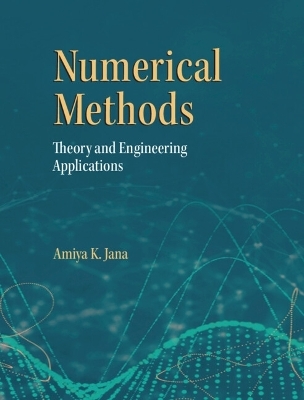
Numerical Methods
Theory and Engineering Applications
Seiten
2024
Cambridge University Press (Verlag)
978-1-009-21180-2 (ISBN)
Cambridge University Press (Verlag)
978-1-009-21180-2 (ISBN)
Numerical methods are a cornerstone of modern engineering. This textbook strikes a balance between the theory and engineering applications, particularly in process applications. Using mathematical problems, illustrative examples and industrially relevant case studies, the book will help students gain physical insights into the ground realities.
Numerical methods are a cornerstone of modern engineering. This lucid textbook strikes a balance between theory and analysis of numerical methods and their practical applications in engineering. Each chapter starts with the formulation and graphical representation of the numerical method. This is followed by the algorithms required to create computer assisted solutions and simulations, which are then applied on real-world examples and case studies to show how exactly they are used. Finally, the strengths and weaknesses of the numerical method under discussion is explained, thus helping the reader choose the best method for a specific problem at hand. Using extensive mathematical problems, illustrative examples and industrially relevant case studies, the book gives the readers physical insights into the ground realities of engineering applications, particularly in areas like heat transfer, fluid mechanics, mass transfer, transport phenomena, and thermodynamics.
Numerical methods are a cornerstone of modern engineering. This lucid textbook strikes a balance between theory and analysis of numerical methods and their practical applications in engineering. Each chapter starts with the formulation and graphical representation of the numerical method. This is followed by the algorithms required to create computer assisted solutions and simulations, which are then applied on real-world examples and case studies to show how exactly they are used. Finally, the strengths and weaknesses of the numerical method under discussion is explained, thus helping the reader choose the best method for a specific problem at hand. Using extensive mathematical problems, illustrative examples and industrially relevant case studies, the book gives the readers physical insights into the ground realities of engineering applications, particularly in areas like heat transfer, fluid mechanics, mass transfer, transport phenomena, and thermodynamics.
Preface; Acknowledgements; Part I. Introduction to Numerical Simulation: Chapter 1. Introduction to Numerical Method and Process Simulation 3; Part II. Systems of Algebraic Equations; Chapter 2. Linear Algebraic Equation 27; Chapter 3. Non-linear Algebraic Equation; Part III. Systems of Differential Equations: Chapter 4. Ordinary Differential Equation: Initial Value Problem (ODE-IVP); Chapter 5. Ordinary Differential Equation: Boundary Value Problem (ODE-BVP); Chapter 6. Partial Differential Equation; Part IV. Function Approximations: Chapter 7. Method of Least-Squares; Chapter 8. Polynomial Interpolation; Chapter 9. Numerical Integration.
| Erscheinungsdatum | 02.11.2024 |
|---|---|
| Zusatzinfo | Worked examples or Exercises |
| Verlagsort | Cambridge |
| Sprache | englisch |
| Maße | 185 x 242 mm |
| Gewicht | 1100 g |
| Themenwelt | Mathematik / Informatik ► Mathematik ► Analysis |
| Naturwissenschaften ► Chemie ► Technische Chemie | |
| Technik ► Umwelttechnik / Biotechnologie | |
| ISBN-10 | 1-009-21180-3 / 1009211803 |
| ISBN-13 | 978-1-009-21180-2 / 9781009211802 |
| Zustand | Neuware |
| Haben Sie eine Frage zum Produkt? |
Mehr entdecken
aus dem Bereich
aus dem Bereich
Band 5: Hydraulik, Stromfadentheorie, Wellentheorie, Gasdynamik
Buch | Softcover (2024)
De Gruyter Oldenbourg (Verlag)
59,95 €


